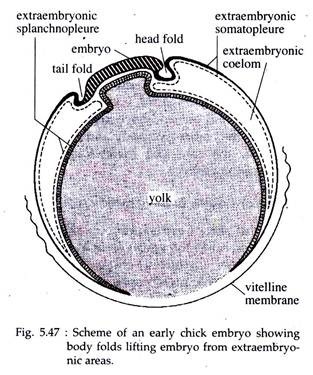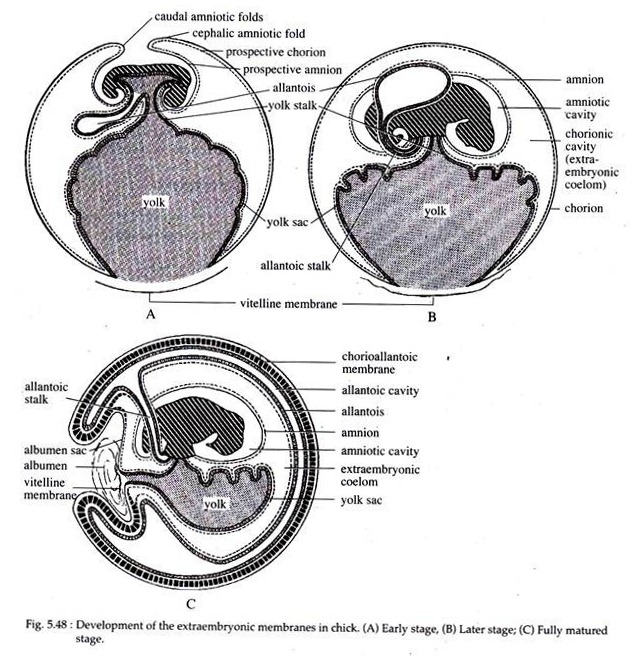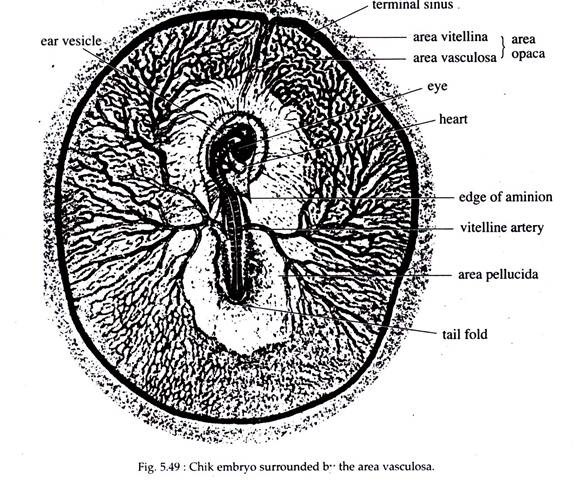In this article we will discuss about the Extra-Embryonic Membranes in Chick:- 1. Meaning of Extra-Embryonic Membranes in Chick 2. Kinds of Extra-Embryonic Membranes 3. Development 4. Functions.
Meaning of Extra-Embryonic Membranes in Chick:
During the development of chick and other vertebrates, certain specialized embryonic tissues or structures are produced that temporarily or permanently do not enter into the formation of the embryo themselves. These are external and devoted in one way or another to the care and maintenance of the developing embryo.
These structures are collectively termed as extra-embryonic membranes or foetal membranes or extra-embryonic sacs. These are not precursors of any of the organs of the adult or the larva but serve to satisfy the requirements of the embryo in connection with nutrition, gas exchange, removal or storage of waste materials and protection.
The extra-embryonic membranes have developed to make the eggs capable of developing on dry land. The eggs of reptiles, birds and prototherian mammals have a protective shell around it. In some reptiles and eutherian mammals the shell has given way to uterine development, but the basic form and function of the extra-embryonic membranes has remained the same.
ADVERTISEMENTS:
Extra-embryonic membranes are those membranes formed of embryonic tissues, which extend out and beyond the strict confines of the embryonic body and are adapted to fulfill the care and maintenance of the developing embryo.
Kinds of Extra-Embryonic Membranes:
Four sets of extra-embryonic membranes are common to the embryos of all terrestrial vertebrates including chick.
These four extra=embryonic membranes in chick are discussed below:
i. Amnion:
ADVERTISEMENTS:
The amnion is a thin membrane which eventually encloses the entire developing embryo in a fluid-filled sac. Reptiles, birds and mammals possessing this amnion are often called amniotes, while fishes and amphibians, lacking it, are collectively called anamniotes.
ii. Yolk Sac:
It is the most primitive structure containing network of blood vessels and encloses the yolk of the egg. A yolk sac is also present in those fishes which have megalecithal eggs. Despite the lack of stored yolk in mammalian eggs (except in prototherians), the yolk sac has been preserved, as it serves many important secondary functions.
iii. Allantois:
ADVERTISEMENTS:
Allantois serves as an excretory and respiratory structure. It is a large sac like structure in reptiles and birds, while its role in mammals varies with the efficiency of the interchange that takes place at the foetal-maternal interface.
In pig embryo, the allantois rivals that of the bird’s in both size and functional importance’s, while the allantois in human has been reduced to a mere vestige which contributes only as a well-developed vascular network to the highly efficient placenta.
iv. Chorion (Serosa):
Chorion is a very thin membrane and it covers the embryo and other extra-embryonic membranes. It is formed by the fusion of the amniotic folds over the embryo. All these extra-embryonic membranes are composite structures as they involve two germ layers.
The amnion and chorion are made up of extra-embryonic ectoderm and somatic layer of mesoderm, while the yolk sac and allantois are composed of extra-embryonic endoderm and splanchnic layer of mesoderm.
Development of Extra-Embryonic Membranes:
During neurulation (neural tube formation) of chick, the lateral plate mesoderm splits into an outer somatic layer of mesoderm lying at the inner side of the ectoderm and an inner splanchnic layer of mesoderm lying outer to the endodermal layer. Both these mesodermal layers enclose a coelomic space between them.
The somatic layer of mesoderm and ectoderm are collectively known as somatopleure, while the splanchnic layer of mesoderm along with endoderm forms the splanchnopleure. At the time of development of the avian blastoderm, the somatopleure and splanchnopleure gradually spread peripherally over the yolk mass, far beyond the area where the body of the embryo is taking form.
Shortly, the embryo proper begins to be undercut by a series of body folds that serve to delimit the embryonic regions from the more peripheral extra-embryonic somatopleure and splanchnopleure (Fig. 5.47). After the formation of the body folds, the somatopleure and splanchnopleure of chick develop into the four extra-embryonic membranes.
i. Development of Yolk Sac:
ADVERTISEMENTS:
The yolk sac is the first extra-embryonic membrane to make its appearance. As the early blastoderm expands, the extra-embryonic splanchnopleure continues to spread over the yolk mass and eventually encloses the yolk completely to form the yolk sac (Fig. 5.48).
Coincidentally, the intra-embryonic splanchnopleure is subjected to superficial body folds, which serve to establish a walled digestive tract or gut, in the body of the embryo. The middle of the gut (mid gut) remains connected with the yolk sac by a narrow yolk stalk, where the walls of the gut is continuous with the walls of the yolk sac.
Although the yolk sac is connected with the digestive tract by the yolk stalk, the yolky food reserves are not transmitted to the embryo by this route. Rather, the digestion of the yolk is done by the endodermal lining of the yolk sac through the mediation of appropriate enzymes.
In chick, on the 2nd and 3rd day of incubation, networks of blood vessels develop on the inner part of the area opaca, which becomes the area vasculosa (Fig. 5.49). The outer part of area opaca is called the area vitellina.
All the blood vessels of area vasculosa communicate with each other and are joined together on the periphery by the terminal sinus, which incidentally forms the boundary between area vasculosa and area vitellina.
The network of the area vasculosa becomes prolonged into the area pellucida and eventually establishes connection with the embryo proper.
Connections with the blood system of the embryo is formed at two points:
(a) With the Venus system by means of the right and left vitelline (omphalomesenteric) veins. These join with the unpaired ductus venosus, which in turn enter the sinus venosus of the heart,
(b) With the arterial system by means of right and left vitelline (omphalomesenteric) arteries, which branch off from the dorsal aorta.
At about the middle of the 2nd day of incubation, the heart of the embryo begins to beat. Between the 38th and 40th hours of incubation the blood starts circulating through the network of the yolk sac. The blood vessels in the area vasculosa penetrate deep into the yolk. The endodermal surface of the yolk sac is thrown into folds that penetrate the yolk mass.
Then, through the action of appropriate digestive enzymes secreted by the endodermal cells, the yolk is digested or made soluble and is ultimately absorbed by the endodermal lining of the yolk sac. It is then passed on through the endothelial lining of the vitelline blood vessels to the circulating blood, from where it is carried to all parts of the growing embryo.
According to Young et al. (1980), the endoderm of the yolk sac in addition to its absorptive function, is also the sole site of synthesis of the serum proteins like transferring, alpha globulins and pre-albumin.
Also during the growth of the allantois, the albumen is forced towards the distal end and gets surrounded by an extension of the yolk sac. It is absorbed along with yolk and transferred by way of the extra-embryonic circulation to the embryo.
The entire yolk is not completely absorbed during embryonic life. On the 19th day when the period of incubation is nearing its end, the remains of the yolk sac are enclosed within the body walls of the embryo.
During the first 6 days after hatching, the resorption of the remaining part of the yolk sac and yolk gets completed. This remaining yolk reserves are vital to the newly hatched chick while it is adapting to a free-living existence and is developing its feeding behaviour.
ii. Development of Amnion and Chorion:
The amnion and chorion are developed simultaneously and both are derived from the extra-embryonic somatopleure. At about the 30th hour of incubation, the head of the embryo sinks somewhat into the yolk and at the same time the extra-embryonic somatopleure is elevated over the embryo by a folding process consisting essentially of a doubling of the somatopleure upon itself.
The initial elevation is over the head end of the embryo, producing a double somatopleuric hood, called the cephalic amniotic fold or head fold of the amnion (Fig 5.48A). From a dorsal aspect, the margin of this fold is crescentic in shape, with its concavity directed towards the head of the embryo. As the embryo increases in length, its head grows forward into the amniotic fold.
As the cephalic amniotic fold gradually extends backward, towards the tail region, its caudally extending side limbs called lateral amniotic folds arch over the embryo from each side to be joined finally by a similar fold or elevation from the tail region called the caudal amniotic fold or tail fold.
All these amniotic folds finally converge at the midline, so as to encase the embryo by two sheets of somatopleure from all the sides except from the region of the yolk stalk. The place where all the amniotic folds meet is called the seroamniotic connection or the amniotic raphe, which is a scar like thickening. The seroamniotic connection opens before the hatching of the embryo and admits albumen into the amniotic cavity.
The fusion of the amniotic folds results in the formation of two sac-like membranes and two cavities. The inner somatopleuric membrane becomes the amnion and the outer one, the chorion or serosa (Fig. 5.48B). The cavity between the amnion and the embryo is called the amniotic cavity and is lined by ectoderm.
Muscle fibres differentiate within the mesoderm of the amnion and the amniotic cavity gets filled with fluid called amniotic fluid. The cavity lying between the amnion and chorion is called the chorionic cavity and is lined by the mesoderm.
This chorionic cavity is actually the extra-embryonic coelomic cavity, which is continuous with the coelomic cavity in the embryo proper. The chorion is lined on the outside by the extra embryonic ectoderm. According to Balinsky (1970) the formation of the amniotic cavity has a somewhat negative effect as it removes the embryo from the source from where it could obtain oxygen.
iii. Development of Allantois:
The allantois first appears late in the 3rd day of incubation. It bulges out as a ventral outgrowth of the endodermal hindgut and corresponds exactly in nature to the urinary bladder of the amphibians. The outgrowth consists of an inner layer of endoderm and an outer layer of splanchnic mesoderm.
The allantois enlarges very rapidly from the fourth day to the tenth day of incubation. It penetrates into the extra-embryonic coelom, into the space between the yolk sac, the amnion and the chorion (Fig. 5.48A and B).
The base of the allantois remains connected with the hindgut of the embryo by means of a narrow allantoic stalk. When the body of the embryo contracts separating the embryo from the extra-embryonic parts, the allantoic stalk and the stalk of the yolk sac remain enclosed together forming an umbilical cord.
The distal part of allantois penetrates between the amnion and yolk sac on one side and the chorion on the other side. By the 4th to 10th day of incubation period, the allantois spreads rapidly and completely covers the coelomic space.
Soon, the mesodermal layer of the allantois becomes fused with the adjacent mesodermal layer of the chorion to form a single mesodermal layer called chorioallantoic membrane (Fig. 5.48C). In the mean-time, the expanding chorioallantois bursts through the vitelline membrane of egg and pushes outward towards the shell membrane.
As it does so it progressively envelops the albumen and becomes a sac filled with albumen, called the albumen sac, that helps in the absorption of water and albumen. The chick embryo, through the chorioallantoic membrane and the shell, takes up about 5 liters of oxygen and gives off about 4 liters of carbon dioxide during its 21 days period before hatching.
On the external surface of the allantois, a network of blood vessels develop and this network is in communication with the embryo proper by means of blood vessels running along the stalk of the allantois and through the umbilical cord.
Blood flows to the allantois through the right and left umbilical arteries, that leaves the dorsal aorta at a point which is much more caudal than the starting point of the vitelline arteries. The returning blood flows to the heart through a pair of umbilical veins that originally enter the right and left ducts of Cuvier.
Soon, the right umbilical artery and the right umbilical vein disappear and the left umbilical vein develops a new connection. It joins the left hepatic vein and the connection with the duct of Cuvier gets closed.
The allantoic circulation functions till the hatching of the chick and when it starts breathing the surrounding air. The umbilical vessels then close. The allantois dries up and separates from the body of the young chick.
Functions of the Extra-Embryonic Membranes:
Development of extra-embryonic membranes are important for those vertebrates that lay their eggs on land. Eggs developing in water, encounter minimum external interference and water provides the egg with various favourable environmental conditions. However, none of the favourable features are provided on dry land where eggs are subjected to desication and sudden changes in temperature.
The extra-embryonic membranes have thus developed to serve the following functions:
i. Functions of Yolk Sac:
(a) The yolk sac which spreads over the large amount of yolk, serves as the digestive and absorptive organ by which the yolk is made available for the growing embryo.
(b) It functions as the first respiratory organ.
(c) It acts as a haemopoetic organ like the liver.
(d) The yolk sac also serves as the place of origin of blood cells, at later stages of development.
ii. Functions of Amnion and Chorion:
(a) The amniotic cavity contains a salty fluid surrounding the embryo. Thus, the embryo can accomplish its development in a fluid medium although it is “on dry land”. Therefore, the amnion serves as a protective organ where the embryo is saved from the danger of desiccation.
(b) The amniotic fluid acts as an efficient shock absorber and thus, protects the soft, collapsible and almost skeletons early chick embryo from mechanical shocks.
(c) As the amnion isolates the embryo from the egg shell, it thus protects it from adhesion to the shell or from friction against it.
(d) The mesoderm of amnion, during later developmental stages, form muscle cells which contract rhythmically, thus rocking the embryo within the amniotic fluid. This rocking prevents the adhesion of amnion to the different embryonic membranes. It also helps in preventing the stagnation of blood in the vessels, a condition that might tend to occur on account of pressure from growing organs.
(e) The chorion at later developmental stage joins with the allantois to serve as a nutritional and respiratory organ.
iii. Functions of Allantois:
(a) Allantois acts as a reservoir for the secretions (excretory wastes) coming from the developing excretory organs. During early stages of development the chick excretes mostly urea, but later it becomes chiefly uric acid. This change is significant as urea is a relatively soluble substance and would require large amount of water to keep it at nontoxic level. Uric acid is relatively insoluble and can be stored without any ill effects.
(b) The chorioallantoic membrane acts as a respiratory surface for the embryo. Thus, the yolk sac, amnion, chorion and allantois can be regarded as an adaptation for the egg and embryo to carry on its development on dry land.


